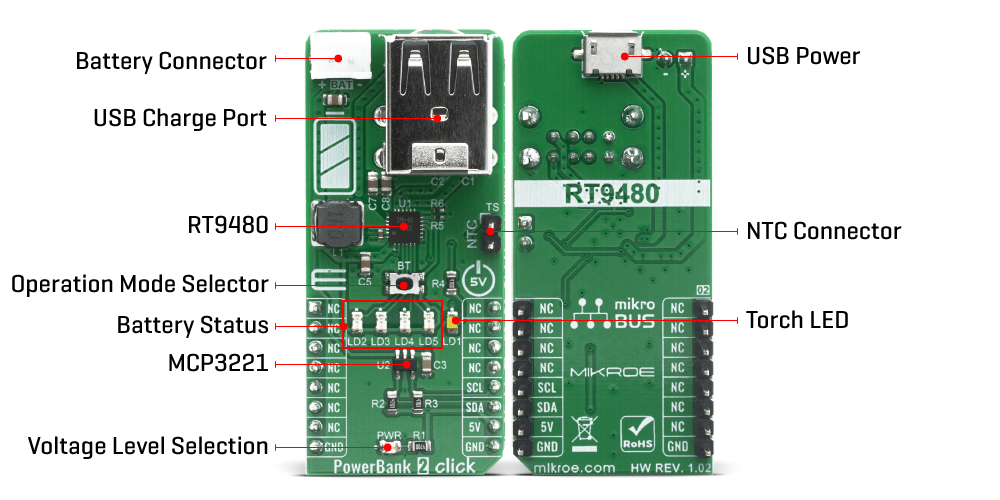






Overview
The PowerBank 2 Click Board™ is equipped with the RT9480, a highly integrated and easy to use power solution for Li-ion power bank and other powered handheld applications. It’s usually called EZPBS (Easy to Use PowerBank Solution). This single-chip includes a linear charger, a synchronous Boost with dual output load management and a torch function support. The battery volume and the state of charging and discharging can be indicated by 4 LEDs.
PowerBank 2 Click is supported by a mikroSDK compliant library, which includes functions that simplify software development. This Click Board™ comes as a fully tested product, ready to be used on a system equipped with the mikroBUS™ socket.
Downloads
How Does The PowerBank 2 Click Board™ Work?
The RT9480 is a high integrated IC for Li-Ion battery power bank. It includes a linear charger 1.2A, a synchronous Boost 5.1V, two output load management, LED indicator and torch function. Based on thermal regulation function, the charging current can support up to 1.2A If the input voltage (VBUS) is higher than the threshold voltage VOVP , the internal OVP signal will go high and the charger will stop charging until VIN is below VOVP − ΔVOVP and if the internal voltage (VMID) is higher than the threshold voltage VOVP, the internal OVP signal will go high and the charger will stop charging until VMID is below VOVP − ΔVOVP.

The converter senses the current signal when the high-side P-MOSFET turns on. As a result, The OCP is cycle by-cycle current limitation. If the OCP occurs, the converter holds off the next on pulse until inductor current drops below the OCP limit. It also has an over-temperature protection. When the junction temperature is higher than the thermal shutdown rising threshold, the system will be latched and the output voltage will no longer be regulated until the junction temperature drops under the falling threshold. In a case of output short to ground, the system will be latched and the output voltage will no longer be regulated until power reset.
There are constant current loop, constant voltage loop and thermal regulation loop to control the charging current. The temperature sense input TS pin can be connected a thermistor to determine whether the battery is too hot or too cold for charging operation. If the battery's temperature is out of range, charging is paused until it re-enters the valid range.
A 4-LEDs indicate attery volume and the state of charging and discharging. Together with torch-light control, the RT9480 provides an all-in-one solution for power banks and similar applications without an external microcontroller. Detailed information about LED indicators can be found in RT9480 datasheet.
The PowerBank 2 Click Board™ is also equipped with a MCP3221, a successive approximation A/D converter (ADC) with a 12-bit resolution to monitor battery voltage over I2C bus over mikroBUS™ socket.
This Click Board™ is designed to be operated only with 5V logic level. A proper logic voltage level conversion should be performed before the Click board™ is used with MCUs with logic levels of 3V3.
SPECIFICATIONS
| Type | Optical |
| Applications | Sub-Battery Applications, Power-Bank Applications for Smartphones, Tablets and Other Portable Devices |
| On-board modules | RT9480 |
| Key Features | Power solution for Li-ion power bank and other powered handheld applications, a synchronous Boost with dual output load management and a torch function support, designed for single-cell Li-ion or Li-polymer batteries |
| Interface | I2C |
| Compatibility | mikroBUS |
| Click board size | L (57.15 x 25.4 mm) |
| Input Voltage | 5V |
PINOUT DIAGRAM
This table shows how the pinout on PowerBank 2 Click corresponds to the pinout on the mikroBUS™ socket (the latter shown in the two middle columns).
| Notes | Pin |  |
Pin | Notes | |||
|---|---|---|---|---|---|---|---|
| NC | 1 | AN | PWM | 16 | NC | ||
| NC | 2 | RST | INT | 15 | NC | ||
| NC | 3 | CS | RX | 14 | NC | ||
| NC | 4 | SCK | TX | 13 | NC | ||
| NC | 5 | MISO | SCL | 12 | SCL | I2C Clock | |
| NC | 6 | MOSI | SDA | 11 | SDA | I2C Data | |
| NC | 7 | 3.3V | 5V | 10 | 5V | Power Supply | |
| Ground | GND | 8 | GND | GND | 9 | GND | Ground |
ONBOARD SETTINGS AND INDICATORS
| Label | Name | Default | Description |
|---|---|---|---|
| PWR | PWR | - | Power LED Indicator |
| LD2-5 | LD2-5 | - | Battery Status LEDs |
| LD1 | LD1 | - | Torch LED |
| BT | - | - | Operation Mode Selector |
| CN1 | - | - | USB Power |
| CN2 | - | - | USB Charge Port |
| General Information | |
|---|---|
Part Number (SKU) |
MIKROE-4116
|
Manufacturer |
|
| Physical and Mechanical | |
Weight |
0.026 kg
|
| Other | |
Country of Origin |
|
HS Code Customs Tariff code
|
|
EAN |
8606018717446
|
Warranty |
|
Frequently Asked Questions
Have a Question?
Be the first to ask a question about this.







